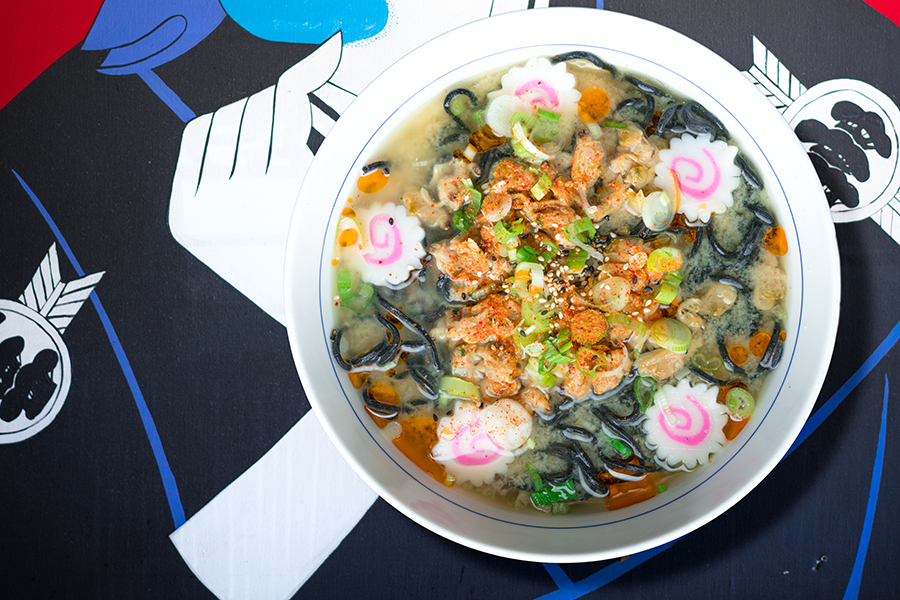In the back corner of Goichi Matsumoto’s kitchen, an almost medieval cast iron device sputters and moans, slowly groaning awake, cogs and sprockets toothily churning out a paradoxically homey aroma of rising wheat. A mixture of wheat flour, salt, water and kansui (a type of high-content mineral oil) seethes within the machine for 45 minutes before giddy swirls of spindly noodles unfold, spiraling to the counter, forming a golden bed of Japanese ramen. Nearly 100 years old, this noodle machine has moved through multiple generations. Born in the Roaring ‘20s, it was owned by Matsumoto’s father and used in his hole-in-the-wall Times Square Japanese restaurant through the ‘70s and ‘80s, where Matsumoto spent almost a decade immersed in the kitchen.
Matsumoto worked under the tutelage of New York chefs Daniel Boulud and Alex Lee, crossed oceans to hone his craft in France, Italy, Switzerland and Japan and finally settled in Florida. In his eponymous, 14-seat, unassuming Sarasota eatery, Goichi Sushi Café, Matsumoto now dreams up ramen bowls in which traditional Japanese broths and spices are flanked by European delights.
Noodles dyed jet black from the ink of a cuttlefish float languidly in the chef’s Ikasumi Ramen, dipping in and out of the beige miso broth like water vipers—the infusion of the onyx sap a technique Matsumoto learned while working in Italy. “We served a braised cuttlefish in its own ink,” he says. “So this creation just came naturally.”
The Monday night special ramen menu boasts some 26 bowls, each singular in taste and texture. Bowls made with the Miso base saturate the palate with sea-salt, cut by chili oil and mild fish such as baby clams. The Shoyu bowls find more balance, with deep soy and savory beef broth, offering an expansion of the senses. The traditional Tonkotsu Ramen does a 180-degree spin, milky and thick, mild and creamy. The Curry broth, Matsumoto’s favorite, is a beef broth taken hostage by a spicy curry roux. “Ramen noodles are kind of like bread in Italy,” Matsumoto says. “Depending on the region, it’s made slightly differently: some broths are more salty, some noodles are curly and crinkled, some are thick. The environment around you changes the dish.”
While playing around with flavors and styles, in 2014 Matsumoto’s muse struck. He invented a cooking style he calls Anatomic Cooking. “I took the human anatomical makeup, starting with the teeth,” he says. “You have about 35 percent carnivorous teeth (your front teeth) and 65 percent herbivore teeth (flat). So with Anatomic Cooking, you have meals that are 35 percent protein and 65 percent vegetation.” According to this technique, ramen is an almost perfect meal—a small portion of pork or beef or shrimp or chicken on top, held simmering in a pool of greens and spices. “It’s very simple food,” Matsumoto says. “It’s filling, it has all the necessary proteins and veggies. It’s a meal in a bowl.”
Taste Test
The Tokyo Ramen has a soy and beef broth (Shoyu), sliced pork, egg, spinach, scallion, bamboo shoots and chili oil. “The Tokyo Ramen is unique in that the base is a fermented beef broth—I get fermented beef powder from Japan,” says Matsumoto. The Ikasumi Ramen is made from a clam and soybean broth (Miso), cuttlefish ink noodles, baby clams, scallions and chili oil. “The ink makes the noodles have a different texture—it’s kind of al dente,” says Matsumoto. The Curry Ramen’s base is a beef broth (Shoyu) with curry roux, with sliced tender chicken, scallions and chili oil. “It’s a deep spice, not like you find with a coconut milk base,” says Matsumoto. “This is more lightweight.”
Goichi Sushi Café, 4563 Bee Ridge Rd., Sarasota, 941-342-7711.









